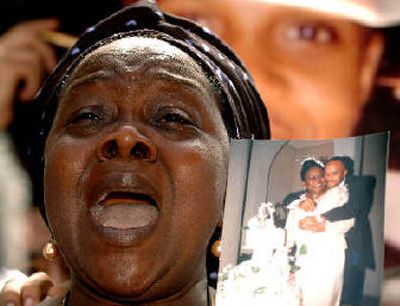Brits worry about more attacks

LONDON – British investigators are focusing on the busy London transportation hub of King’s Cross in their search for clues into last Thursday’s bombings, which officials say killed at least 52 people.
One train was eight minutes east of King’s Cross when a bomb aboard it exploded. Another was eight minutes west. The third was just seconds south. And the double-decker bus was only a short walk away when the bomb aboard it – the last of four – went off.
“The coincidence of all the trains coming through here is obviously one line of inquiry we are pursuing,” Deputy Chief Constable Andy Trotter of the British Transport Police said Monday.
The focus on King’s Cross comes as experts worry that the people who planted the bombs probably escaped and may be planning more attacks.
“The evidence we’ve seen indicates a grave danger,” said Magnus Ranstorp, deputy director of the Centre for the Study of Terrorism and Political Violence at the University of St. Andrews. “Last year in Madrid, (Spain), the bombers had a large amount of explosives and looked to be preparing to launch new attacks. We have to assume that it is the case here as well.”
Dick Leurdijk, who studies terrorism at the Clingendael Institute, a Dutch research center, offered a similar view.
“If the purpose of terrorism is to create terror, a second attack coming in the next few days would be a serious blow to the European notion of security,” he said. “This looks to be the work of terrorists with an international agenda, so the attack needn’t come in London, or on the subway. But every European capital is on high alert right now, and with reason. A number of people are convinced another attack is coming.”
British Prime Minister Tony Blair told Parliament that it now “seems probable the bombs were the work of Islamic extremist terrorists.”
He pledged to introduce new anti-terror laws and to give police whatever powers they need to find the bombers.
“We will not rest until they are identified and, as far as humanely possible, brought to justice,” he said.
Trotter said police have not ruled out the possibility that the bombers died in the explosions. But he said investigators believe the explosions were more likely triggered by timing devices. King’s Cross would be a fairly simple place from which to escape after planting explosives.
One of London’s major rail hubs, King’s Cross is served by six subway routes, including the Circle and Piccadilly lines, the two lines on which three bombs exploded within seconds of each other.
Above ground, passengers can board trains that run up the eastern edge of England into Scotland, or a number of buses, including the number 30 bus, the doomed double-decker that suffered the last explosion when a bomb went off about an hour after the subway explosions.
Tens of thousands of people cross through the station every hour to take a train, a subway or a bus. Euston, another major rail hub, is only blocks away.
Trotter said investigators are pouring through closed circuit television images of the station looking for anything suspicious.
Video images from the bus may be less useful – the camera aboard the bus was badly damaged, Trotter said – though police are hopeful the images will clarify the role of a man who survivors describe as fiddling nervously with a package on the floor shortly before the explosion. Trotter said there is no evidence that the man had any involvement with the bombing.
Meanwhile, Metropolitan Police Chief Sir Ian Blair said he expected the official death toll would continue to climb as rescue workers complete the task of pulling body parts from the twisted wreckage of the Piccadilly line train that was struck seconds after it left King’s Cross on its way to Russell Square.
That explosion claimed the most victims – now estimated at at least 25 – in part because the train was packed with morning commuters and because the tunnel it was traveling through, 100 feet underground, was especially narrow, multiplying the force of the explosion.
Workers Monday removed the last clearly visible pieces of victims from the train, but said other bodies could still be trapped under the trains, which workers have been unable to move.
Officials released the name of the first person confirmed dead in the bombings, Susan Levy, 53, a married mother of two. The University of London announced that a cleaning woman at the school, Gladys Wundowa, 51, died in the blast.
Officials have said it may take weeks to identify all of the dead, many of whom were blown apart by the explosions.
Blair said investigators are working their way through 2,500 tapes from closed circuit television cameras in hopes of spotting the bombers and are conducting “fingertip searches of hundreds of yards of tunnel.”
Blair said police have concluded the bombs were sophisticated, made of military-grade high explosives, and relatively small, 10 pounds or less each.
“The bombs were certainly not homemade,” he said.